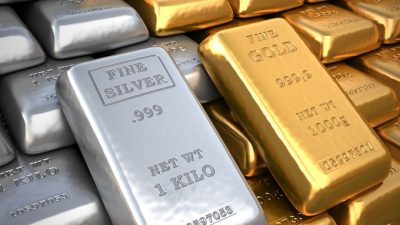The Next Currency Crisis, When? Impacts on the Prices of Gold and Silver

With government money printing and debt loads skyrocketing out of control, it seems that Rick Rule is likely correct that the next currency crisis is a matter of “when” rather than “if.” And when that occurs, it’s fascinating to think about what might happen to the prices of gold and silver when people start to buy on a retail level.
Sure, there were some funds who invested in GLD or SLV. And there was likely more interest in the mining shares as well. Yet outside the libertarian/Austrian economics/sound money community, I would be stunned if even more than 1% of the population owned physical gold or silver at any point in 2011.
Meanwhile gold and silver prices sit well below their highs. With silver even lower than it was when the debt was $10 trillion, and the Fed’s monetary base was under $900 billion prior to the housing crisis.
Why is that you ask?
Now if this sounds rather shocking and unbelievable to you, I can certainly understand. However fortunately you don’t have to take my word for it, as Deutsche Bank, Bank of Nova Scotia, and J.P. Morgan have already been caught. With Deutsche Bank releasing a series of stunning trader transcripts which detail the crime. While the former J.P. Morgan trader who recently plead guilty to manipulating the markets and stated that “he learned this deceptive trading strategy from more senior traders at the Bank, and he personally deployed this strategy hundreds of times with the knowledge and consent of his immediate supervisors”.
Currently a Department of Justice investigation is ongoing. While Congressman Alex Mooney is now pressuring the CFTC to explain why it was never able to find what has now been exposed.
Because as gold and silver prices rise, more people start to notice that something is going on and begin to buy.
Historically, rising gold and silver prices have represented a great threat to governments that are reliant on printing and borrowing. Because it’s important to remember that at this point, every single thing that the U.S. government does, including hiring employees, building tanks, and all of the other wasted spending are funded by printed or borrowed money. And when that funding source is removed, a lot of what we know as government is either going to have to find a new means of revenue, or simply cease.
So whenever the incredible fractional reserve paper money system can simply no longer be expanded any further, watch out for gold and silver. Because if gold went to $1,900 and silver went to $49 without anybody really owning physical metal, what price will they reach when the public starts buying?
What price will they reach whenever the dollar is officially more further rebuked by the foreign markets? That have already been selling treasuries, building non-dollar trade facilities, and even creating non-dollar oil markets like the PetroYuan.
If you have any questions about this article, as always I look forward to your comments here. It’s a fascinating time in history. And one which will likely bring significant changes to the financial and political landscape of the world.
Which is why taking the Federal Reserve and Washington’s market assessments with a grain of salt is often a wise idea. While looking at what they’re doing with their own actions and money can be a lot more helpful when deciding what to best decide for yourself.
*
Note to readers: please click the share buttons below. Forward this article to your email lists. Crosspost on your blog site, internet forums. etc.
This article was originally published on Arcadia Economics.
Chris Marcus is a former NYSE equity options trader turned Austrian Economist, who now runs Arcadia Economics. A blog site where he shares what he discovered inside Wall Street so that when the next bubble crashes, his readers and clients are prepared and ready.

